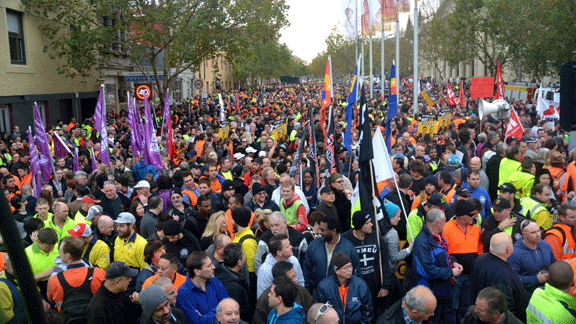Union action can beat back Abbott

On 12 June, Melbourne got a glimpse of the power that can stop Abbott’s slash and burn budget.
More than 20,000 unionists marched from Trades Hall in Carlton to the steps of Parliament House. It was the biggest anti-budget protest yet and a sign of the potential power that can be wielded against the Liberals’ assault on what remains of the welfare state.
On the same day, hundreds of union delegates met in Sydney to plan action for 6 July, which is set to be a major national protest on the eve of the new Senate’s first sitting day.
The Melbourne march was bigger than the emergency protest held on 18 May. But the sizeable turnout was not its most important element. What made this protest significant was that it was a mobilisation of the labour movement – the force that had been largely missing from the anti-budget campaign.
Until now students have led the way, taking to the streets in their thousands and dogging Liberal politicians wherever they go. The student demonstrations – which we are proud to say Socialist Alternative students played a pivotal part in – were crucial to getting the protests against this budget going. The tens of thousands who came out for the “March in May” also played a vital role in ensuring that the budget would be not just resented, but resisted.
The union movement brings something greater to the table than just the numbers it can get on the streets. Those who marched on 12 June did so under the banners of unions big and small from across the state. They were construction and manufacturing workers; electricians and plumbers; nurses and other health care workers; power and transport workers; public servants and teachers; wharfies, firefighters and factory workers. Collectively, their labour keeps the wheels of the economy turning. Collectively, they also have the power to bring the system to a halt.
This is the power that can make the Liberals and their mates in the corporate boardrooms think twice.
Just consider it. It is one thing for the government to languish in the polls while student socialists are filling the airwaves with shouts of protest. The rich don’t like it, but they can live with it – at least for a while. It is another thing entirely if trying to push through this budget means construction sites grind to a halt, if it means stoppages that shut down the schools and the power plants, if it means strikes and walkouts in the hospitals, on public transport and on the wharves.
That kind of industrial action, in combination with street protests and a political campaign against the budget, could consign it to the dustbin of history in short order.
But despite the success of 12 June, we are still a long way from such action. The ACTU leadership has refused to take a lead in agitating against the budget, let alone mobilise the full weight of the union movement. In Victoria, Trades Hall has been willing to organise big protests, but no section of the union movement has been prepared to provide serious leadership. While it is positive that Unions NSW will be joining the mass protest on 6 July, the union response outside of Victoria has generally been negligible.
This in part reflects the decades-long decline of the union movement as a major force in Australian politics. For far too long, the unions have taken the advice of the ALP spin-meisters who tell them that they need to save their strength, “keep their powder dry” and “box clever” so as to live to fight another day.
The problem is that if you box clever for long enough, you end up forgetting how to box. There is little institutional memory of the traditions and methods of struggle that built the Australian trade union movement into the powerful force that it was by the mid-1970s.
This budget is a chance to start to turn the situation around, to start to rebuild a trade union movement that is about collective organisation and action to fight the bosses and the government.
It is crucial that the left apply the greatest pressure possible to push the current union leadership into action. But what is more important is putting in the hard yards to start to rebuild a culture of militant unionism from the ground up.
The greatest blow to the trade union movement in the dark years of the Accord with the Labor government in the 1980s, which oversaw the sharpest decline in union power since the 1930s Depression, was not the grubby wage deals done by the ACTU, or the incorporation of the union leadership into the policy framework of the rightward moving ALP. That was bad enough. But what hurt the most was the wholesale destruction of the remaining networks of delegate and shop steward organisation, which had been the backbone of union militancy in the 1960s and 70s.
That network of rank and file organisation was constructed over decades by socialists in the Communist Party and in the left of the ALP. It will not be easy to rebuild. Doing so will require backbreaking, painstaking work in industry after industry.
Nonetheless, there are no shortcuts or silver bullets. Rebuilding ground-up organisation and militancy is the crucial task that faces all those who want to see a workers’ movement that is once again the kind of fighting force that can take on and defeat a reactionary government like the one we face today.